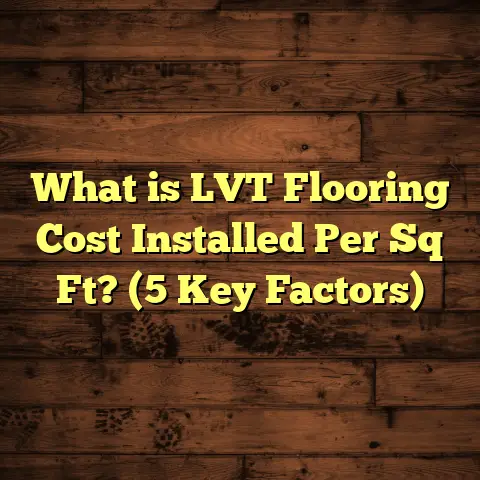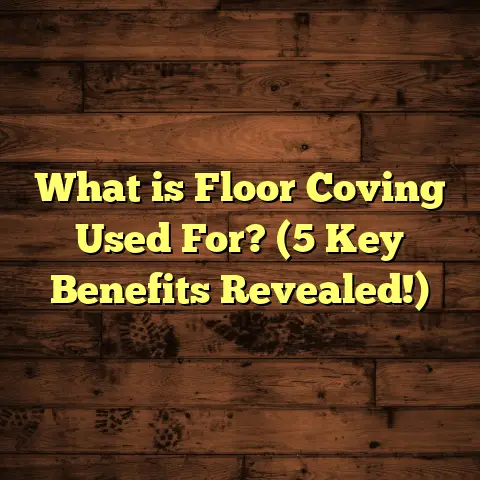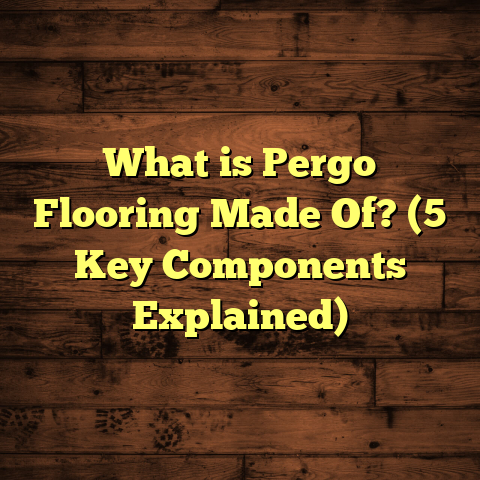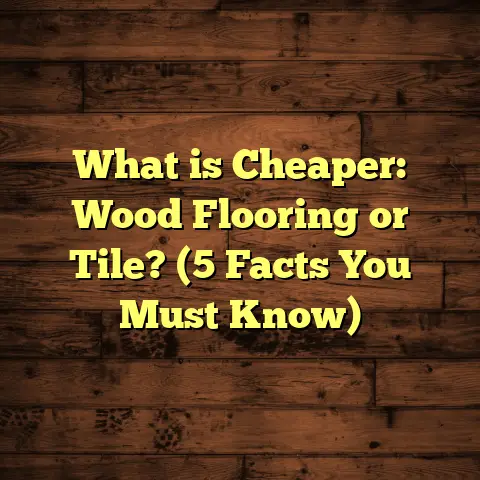What is Flooring? (5 Types You Need to Know for Your Home)
Back in ancient times, floors were more than just a foundation underfoot—they told stories. In Egyptian tombs, you’ll find intricately laid stone floors designed to last for millennia, reflecting status and craftsmanship. The Romans took it further with their mosaic tile floors, combining art and function. Fast forward a few thousand years, and the floors in Victorian homes speak of elegance and style with their hardwood planks and patterned tiles. Floors have always been a vital part of a home, influencing comfort, aesthetics, and even the way we live.
When I think about flooring, I picture all those layers of history beneath our feet—each telling a story of culture, technology, and design. Whether you’re walking on polished hardwood in a colonial house or cushy carpet in a modern apartment, flooring shapes how we experience our spaces.
What Is Flooring?
Flooring is the material installed on top of the structural subfloor to create a finished surface you walk on inside a building. It’s one of the most fundamental parts of any interior, combining the practical need for durability and safety with design and atmosphere.
But flooring isn’t just about what lies beneath your shoes. It impacts insulation, acoustics, hygiene, and even health by affecting allergens and indoor air quality. Think about it: what you choose for your floors influences cleaning habits, how warm or cool a room feels, and even the resale value of your home.
I’ve spent years helping homeowners navigate these choices, and I keep learning new things every project. Here’s what I’ve found to be the five flooring types every homeowner should know about.
Hardwood Flooring: Classic Beauty and Longevity
Hardwood flooring has been around for centuries and remains one of the most sought-after choices for homes that want to combine beauty with durability. Made from solid wood planks cut from trees like oak, maple, cherry, or walnut, hardwood is prized for its natural look and feel.
The Appeal of Hardwood
One thing that always stands out to me about hardwood is its timelessness. When I go into a home with freshly refinished hardwood floors, it feels like stepping into a warm embrace. The wood grain patterns are unique to each plank—no two floors are exactly alike. Over time, hardwood develops a patina that only adds character.
In many older homes I’ve worked on, hardwood floors were either hidden under carpet or damaged but salvageable. Refinishing them restored the home’s soul. That’s something synthetic floors can’t replicate.
Durability That Lasts Generations
Hardwood floors can last 50 to 100 years if maintained well. They can be sanded and refinished multiple times to remove scratches or wear marks—something laminate or vinyl can’t do.
I remember helping a client whose 80-year-old hardwood floor had some deep scratches and discoloration from years of pets and kids running around. After sanding down and applying a new finish coat, it looked nearly brand new. They were amazed that their floor had so much life left.
Installation Insights
Hardwood installation requires a flat subfloor and careful acclimation of wood planks to room humidity before installation. Nail-down or glue-down methods are common depending on subfloor type.
I always advise clients to hire pros for hardwood installation unless they’re very experienced DIYers because improper installation can lead to squeaky floors or gaps later.
Maintenance Tips
- Use felt pads under furniture legs to prevent dents.
- Avoid excessive water; wipe up spills promptly.
- Clean regularly with a soft broom or vacuum attachment designed for wood.
- Refinish every 7-10 years depending on wear.
Cost Breakdown
Hardwood is generally on the higher end cost-wise. Material costs range from $4 to $10 per square foot depending on wood species and grade. Installation labor adds $3-$6 per square foot on average.
A typical 1,000 sq.ft room might cost between $7,000-$15,000 installed. That’s why budgeting tools like FloorTally are super useful—they help me calculate realistic estimates including waste factor (usually 5-10%) so clients don’t get surprised by extra expenses.
Laminate Flooring: Affordable Style with Some Limits
Laminate flooring exploded in popularity in the early 2000s as an affordable alternative to hardwood that still looked good. It consists of fiberboard core layers topped with photographic images of wood or stone textures sealed under protective wear layers.
Why Laminate Works for Many Homes
Laminate is great if you want the look of real wood but need a budget-friendly option. It’s also very durable against scratches and stains—perfect for busy households with kids or pets.
One time, I installed laminate in a rental property where the owner wanted something durable yet easy to swap out when tenants moved out.
Installation Made Easy
Most modern laminate uses click-lock systems that let you float the floor over existing surfaces without nails or glue. This speeds up installation and makes it accessible for DIYers.
However, laminate must be installed over a smooth, flat underlayment or foam padding to prevent damage.
Limitations to Keep in Mind
Laminate isn’t very moisture-resistant. If water seeps into seams or under the floor, swelling occurs which ruins planks. So it’s not ideal for bathrooms or basements unless you pick waterproof types (which can be pricier).
Also, laminate cannot be refinished like hardwood—once worn or damaged, you replace planks entirely.
Real-World Example
I once helped a couple who wanted wood-look flooring but had tight funds due to recent home repairs. We chose mid-grade laminate with textured surface for realism. It transformed their living room in days without breaking the bank.
Care & Cleaning
Laminate cleans easily with dry mops or slightly damp cloths—harsh cleaners can strip surfaces though. Avoid standing water.
Vinyl Flooring: Practical Choice for Busy Homes
Vinyl flooring is made from PVC plastic and comes in sheets, tiles, or planks. It has evolved dramatically in recent years with luxury vinyl plank (LVP) offering very authentic wood or stone visuals combined with waterproof resilience.
Why Vinyl?
Vinyl is tough against moisture making it ideal for kitchens, bathrooms, basements—even commercial spaces. It also feels softer underfoot than tile or hardwood which adds comfort.
I’ve installed vinyl floors in rental units where durability was key—the owners appreciated how easy it was to clean and maintain.
The Rise of Luxury Vinyl Plank (LVP)
LVP mimics hardwood so well that it’s hard to tell apart without close inspection. It has textured surfaces and realistic color variation.
Installing vinyl is quicker than tile or hardwood due to adhesive options or loose lay methods.
Maintenance Benefits
Vinyl needs minimal upkeep—just sweep and mop regularly. Its waterproof nature means spills don’t cause damage.
Cost Considerations
Vinyl runs $2 – $7 per square foot installed depending on quality and thickness. That makes it accessible without sacrificing style or function.
Tile Flooring: The Durable Art Form Underfoot
Tile floors have been around since ancient times too—think Roman mosaics or Moroccan zellige tiles—and they still hold strong appeal today due to durability and design variety.
Ceramic vs Porcelain Tile
Ceramic tile is made from red or white clay fired at lower temperatures making it porous but less dense than porcelain tile which fires hotter for greater hardness and water resistance.
Porcelain tiles are best for bathrooms or outdoor patios due to superior durability but cost more upfront.
Design Possibilities
From large-format tiles creating seamless modern looks to intricate patterns bringing personality to entryways—tile offers endless style options.
One memorable job was installing hand-painted Spanish tiles in a kitchen backsplash paired with terracotta floor tiles—a combination full of warmth and charm.
Installation Challenges
Tile installation is labor-intensive needing precise layout planning, cutting tiles accurately, applying mortar evenly, and grouting properly so water doesn’t penetrate below.
I recommend skilled installers for tile projects to avoid future cracking or loose tiles.
How Long Does Tile Last?
If installed right, tile can last over 50 years with minimal wear beyond occasional grout cleaning/resealing.
Carpet: Softness That Makes a House Feel Like Home
Carpet brings softness and warmth unmatched by hard surfaces—great for bedrooms or family rooms where comfort matters most.
Types of Carpet Fibers
- Nylon: Durable & stain-resistant.
- Polyester: Soft & affordable but less resilient.
- Wool: Natural fiber with excellent longevity & feel but pricier.
I’ve helped clients select carpets based on lifestyle—families with kids often prefer stain-resistant nylon blends while luxury buyers lean toward plush wool carpets.
Carpet Construction Matters
The pile type (cut vs loop), density, and weight influence carpet feel and durability as much as fiber type does.
Deep Dive: Installation Techniques & Tips I’ve Learned Over Time
Installation quality affects flooring lifespan as much as material choice does. I’ve seen beautiful hardwood ruined by uneven subfloors causing gaps or squeaks. Likewise, tile installed poorly leads to cracked grout lines within months.
Here are some tips from my experience:
- Always ensure subfloor is level within manufacturer tolerances.
- Acclimate wood products at least 48 hours indoors before installation.
- Use moisture barriers when installing over concrete slabs.
- Don’t skimp on underlayment; it adds comfort & sound insulation.
- For DIYers: watch detailed tutorials & invest in proper tools.
The Financial Side: Budgeting Flooring Projects Smarter
Budgeting for flooring can get complicated fast—material costs vary widely depending on quality and style; labor rates depend on region; additional costs can include moving furniture, removing old flooring, prepping subfloors etc.
That’s why I find tools like FloorTally invaluable—they factor in local material prices, labor rates from contractors nearby, waste allowance (usually 5%-10%), and give me detailed cost breakdowns instantly.
Using FloorTally has saved me hours by eliminating guesswork during client consultations—a huge plus when juggling multiple projects at once.
Comparing These Flooring Types Side by Side
| Flooring Type | Durability | Cost (per sq.ft.) | Maintenance | Best For |
|---|---|---|---|---|
| Hardwood | High (20+ years) | $6 – $12 | Moderate (refinishing needed) | Living rooms, bedrooms |
| Laminate | Moderate (10-20 years) | $1 – $5 | Low (avoid moisture) | Living rooms, basements (dry) |
| Vinyl | High (20+ years) | $2 – $7 | Very Low | Kitchens, bathrooms |
| Tile | Very High (50+ years) | $5 – $15 | Low (grout cleaning) | Bathrooms, kitchens |
| Carpet | Moderate (5-15 years) | $3 – $7 | Moderate (vacuum + cleaning) | Bedrooms, playrooms |
Each type brings something different to the table. Hardwood offers unmatched beauty but costs more upfront. Laminate gives you a budget-friendly alternative that looks good but doesn’t handle moisture well. Vinyl balances affordability with waterproof convenience. Tile delivers durability and style but requires careful installation. Carpet adds softness and warmth but needs regular upkeep.
Questions You Might Have About Flooring Choices
Q: Which flooring is best if I have pets?
Hardwood can scratch easily while laminate resists scratches better but not moisture. Vinyl is often best due to scratch resistance plus waterproof qualities making cleaning easier after accidents.
Q: Can I install flooring myself?
Laminate & vinyl planks are designed for DIY installation but hardwood & tile usually require professional installers unless you have experience with carpentry or tiling skills.
Q: How do different floors affect indoor air quality?
Hardwood & tile don’t trap dust/mold like carpet can which may benefit allergy sufferers. However, choosing low-VOC finishes and adhesives also matters regardless of flooring type.
Final Thoughts from My Experience
Choosing the right flooring isn’t just about picking what looks good—it’s about matching your lifestyle needs, budget constraints, long-term maintenance willingness, and even resale goals.
For me personally, hardwood remains my favorite because of its lasting beauty and ability to be refreshed again and again through refinishing. But I also appreciate laminate’s affordability when budgets get tight, vinyl’s practicality in wet rooms, tile’s unmatched durability in high traffic zones, and carpet’s cozy softness where comfort rules.
Each home is unique—and so should its floors be!
If you’re ready to plan your next flooring project but want a clearer picture of costs ahead of time like I do on my jobsites—try using tools like FloorTally for quick local price estimates that factor in labor plus materials. It helps save guesswork during consultations and keeps budgets realistic from start to finish.
At the end of the day though? No matter which floor you choose—it’s what makes your house feel like home every step you take inside it.





